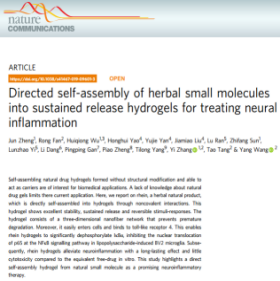On April 8th, the team led by Associate Research Fellow Wang Yang and Professor Tang Tao from the Department of Traditional Chinese Medicine and Western Medicine of Xiangya Hospital of CSU, and Professor Zhang Yi from the School of Chemistry and Chemical Engineering of CSU jointly published in the international top journalNature Communications(IF=12.353, JCR-1, Nature Index Journal) the study results of preparation of traditional Chinese medicine natural small molecule rhein hydrogel and its medical application - “Directed self-assembly of herbal small molecules into sustained release hydrogels for treating neural inflammation” as an Original Article. Dr. Zheng Jun from the School of Chemistry and Chemical Engineering of CSU, and Associate Professor Fan Rong from the the Department of Traditional Chinese Medicine and Western Medicine of Xiangya Hospital are co-first authors, Professor Zhang Yi, Professor Tang Tao and Associate Research Fellow Wang Yang are the co-corresponding authors. CSU is the unit of the first authors and the corresponding authors, and Xiangya Hospital is the unit of the first author.

The preparation of natural small molecule directed self-assembled hydrogel is an international hotspot. Because it does not require molecular modification and drug delivery carrier, it can avoid unknown toxic side effects and biodegradation, and can provide three-dimensional scaffold for cell growth to play the role of sustained release of drug. The team screened out brain active ingredient rhein (from Rheum officinale) from more than 100 kinds of traditional Chinese medicine small molecules, and successfully allowed it subjected to directed self-assembly into a 3D fiber hydrogel. Rhein is both a pharmacodynamic molecule and a delivery carrier, and has good sustained release performance and biocompatibility. The experimental results show that the drug release time of the rhein hydrogel is longer than that of the monomeric form, which can significantly increase the surface binding to TLR4 and inhibit the inflammatory reaction of BV2 microglia cell line. The study has applied for two Chinese invention patents, one of which has been granted (patent number: ZL201710060004.2). Undergraduate students Yao Honghui, Yan Yujie and Liu Jiamiao from the Xiangya School of Medicine of CSU participated in the study as co-authors.
It is reported that the team led by Associate Research Fellow Wang Yang and Professor Tang Tao has long been committed to the basic and clinical research on the diagnosis and treatment of hemorrhagic brain injury (cerebral hemorrhage, traumatic brain injury, etc.). With the support of Xiangya Hospital, the team has formed a stable dual principal investigator (PI) team with Professor Zhang Yi from the School of Chemistry and Chemical Engineering. It plans to carry out a series of studies on the directed self-assembly of rhein into hydrogel by leveraging the multidisciplinary advantages of CSU.
Source: Xiangya Hospital











